
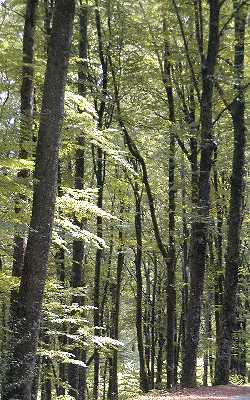
From the River Tarn to The River Lot
Ségala, a sumptious visual joy,
a scenic
“tour de force”
a “trou”, ruby-hued “grès” and precious
stones.
by award-winning travel writer and best selling author, Richard Binns
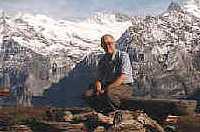
I would imagine that most tourists, crossing the heart of France, looking at their maps, would dismiss it as dull, uninteresting terrain. Once
again I shall try to prove to you the essential element of surprise, one which unfailingly rewards those who pocket their prejudices and travel
instead with open minds and receptive hearts.
The landscape is dominated by river valleys. Five are especially notable: from south
to north the “Tarn”, the “Viaur”, the “Aveyron”, the “Dourdou” and the “Lot”.
I’ll describe each valley and the nearby countryside, in turn, giving most space to the lesser known scenic attractions.
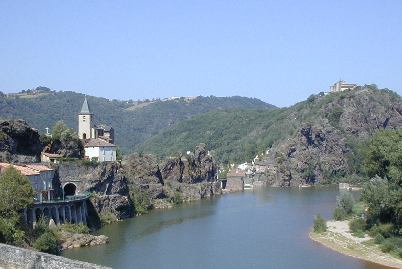
Start your exploration of an unknown stretch of the Tarn to the east of Ambialet (which, in turn, is to the east of Albi). The village and the aptly-named Pressqu’ile d’Ambialet are a scenic ’tour de force’ river sculpture. As you approach Ambialet you plunge into a short 20 metre-long tunnel; beware, there’s a stop sign at the end of the tunnel exit. Turn right at the cross-roads and follow the road up to the ’prieuré’; walk to the viewpoint. Now you’ll see what an unusual meander lies both behind and below you. The two curves in the river to the south almost touch; at the narrowest point there’s a small ornate château-style building. In fact this is an electricity generating station; water is allowed to flow through an underground channel which bridges the 15 metre-wide gap and this is the reason why the loop to the north has such a dried-up look. I’ve also seen the Tarn, after monsoon rains, in flood unsurprisingly the colour of red sandstone.
To the north of Ambialet, between the old coal-mining town of Carmaux and Requista, there’s a long, high, ridge of hills; the villages on the D91 and the D903 are really not up to much except for the beautiful lilies you see everywhere; the views north and south are extensive and exceptional. I would want to get back to the Tarn. After you’ve seen something of the Viaur (more of that valley later) drive south again to magical Brousse le Château.
What a seductive spot Brousse is, sleeping contentedly on it’s perch above the Tarn and alongside the Alrance. Every wall of the half-timbered and stone houses appears to be rose-covered and, alongside the Alrance stream, are many colourful vegetable and flower gardens. There’s a ruined castle with towers and ramparts high above the houses; a ’pont roman’; narrow alleys (calades) paved with giant cobblestones; an ’église’ with an open three bell tower; and weir upstream on the Tarn.
The Lac de Villefranche de Panet is a surprisingly pleasant man made lake: the banks are wooded, there’s a beach, plenty of reflections and pédalos. Do as I did and drive to the Tour de Peyrebrune (3,000ft above sea-level) for some fine views; there’s a modern flight of stairs in the tower.
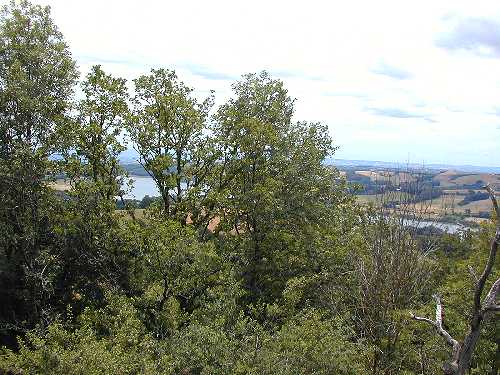 |
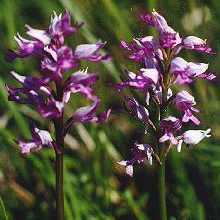 We continued north-east, past Calmejane and, just west of La Fraysse, we braked hard at the sight of a spectacle the like of which we had not seen anywhere else in France: a field to our right had such a dense covering of ’orchis militaris’ that the entire surface was washed with a dense pink colouring. |
No wonder the field is protected by barbed wire Driving on a little further, we came to the Lac de Paraloup, an enormous water playground, whose
wooded inlets are an attractive bonus, as are the beaches and water sport facilities. On the eastern shore, at Les Vernhes, there is a marina, from which it is possible to take a cruise on the lake.
Back to the second river, the “Viaur”, I would give time again to the network of tributaries feeding the Viaur to the east of the N88, where the road crosses the wooded Gorges
du Viaur. Start at the grim looking Château du Bosc, associated with Toulouse Lautrec’s childhood, south east of Naucelle. After your visit descend to Castelpers, flower filled and
alongside the River Céor. Follow the stream west to it’s confluence with the Viaur. Detour north to the viewpoint at Puech (hill) de Rouet and the back again to the Viaur, continuing
downstream. This is heavenly country: roses blooming, cattle bellowing, water murmering and lizards scuttling.
 |
Just before the N88 man does his bit to impress: the 100 year old Viaduct de Viaur spans the gorge 120 metres
above you. The single arch railway bridge, an immence necklace of steel tubing and struts, is an engineering marvel. |
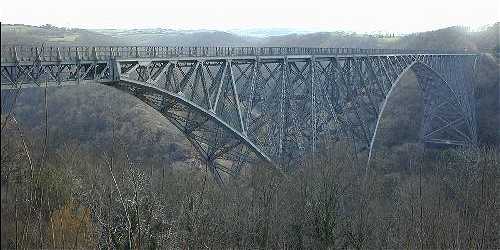 |
Further downstream two spots are easily reached. Below Pampelonne the D78 snakes down, through woods, to the
valley floor; from the tower ruins at Thuriès you’ll understand why the river is throttled downstream: courtesy of an EDF
dam. Pont de Cirou, a few kms to the west, is an isolated place; one quirk is the départment and kilometre stone bang in the
middle of the old bridge.
This is very much walkers’ country; note the footpath which runs along the
river’s left bank from Tanus, on the D88, to Pont de Cirou, past the remote église Notre-Dame de Las Planques.
Naturalists among you will appreciate the absence of roads among the trees and plants. Perhaps you’ll be lucky enough to
catch a glimpse of otters or herons.
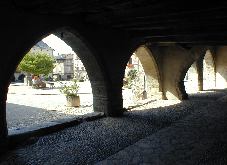
Sauveterre de Rouergue |
Between the River Viaur and the River Aveyron (the third of the five rivers) is the centre of the ’pays’ called “Ségala”. At its high heart is an architectural treat: the small ’bastide’ of Sauveterre de Rouergue. The arcaded ’place’ is a handsome square. Also worth looking at is the église at Naucelle with fine stained glass windows. Another tip: one of the best fresh cow’s milk cheeses I’ve ever tasted in France was made at Le Taurinol Farm at Taurines, east of the château at Bosc (see earlier reference), on the road to Cassagnes-Bégonhès. | 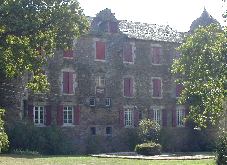
Château de Bosc |
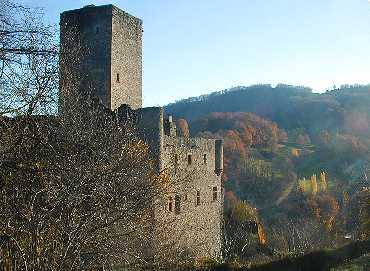
The “Aveyron”, like the Viaur, has few roads alongside its banks. Certain spots are worth the detour. Rodez (capital of the Aveyron Department) is the architectural highlight: the sandstone Cathédrale Notre-Dame is magnificent, especially the ornate bell tower; see, too, ’vieux’ Rodez (south of the cathedral) with many splendid ancient houses, noted for their galleries and interior courtyards. Upstream from Rodez nose out tiny La Loubière with an église and pretty riverside aspect; that’s true, too, of Montrozier with a sturdy looking Renaissance château. But the best is Belcastel (west of Rodez) a sumptuously scenic joy: cobbled ’calades’; a bend in the river and a medieval ’pont’ spanning the 20 metre-wide river.
Now to the fourth river, the “Dourdou” the least well known and I think perhaps the best of the five. Start at Bozouls. From a viewpoint just yards from the D20 admire the astonishing ’trou’ below you: a wooded ’cirque’ where the river has formed a stunning loop. At the heart of the giant meander, above the river, is a Romanesque église’, built from the local sandstone (’gres’). Continue north-west on the D20 and then drop down to Rodelle: the deep wooded valley is the first major surprise; the village’s rocky site, on a high spur, is the second. Continue downstream to the Lot. What a superb valley: by Villecomtal you will have noted that all buildings are made from the local ’gres’, a rich ruby-hued sandstone; note, too, the shapes and shades of the ’lauzes’ (roof tiles) and admire the startling contrast of fallow emerald pastures and ploughed fields.
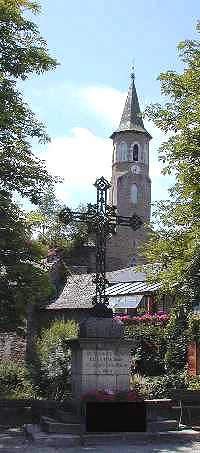 |
Halfway down the Gorges du Dordou, make the essential climb to Conques. The 11th Century
église is a Romanesque gem: the three spires, high nave, majestic sculptures of the peerless tympanum and the famed treasure (including the
glorious gold-covered statue of St Foy, enriched with precious stones) make Conques a three star wonder. I have never been very much impressed by the Gorges du Lot, upstream from Entraygues. The wooded river valley, downstream, is much more appealing (and the lanes that climb up from the Lot). I especially love the area round Flagnac, the site of a simple but stirring annual ’spectacle’ : “Hier, Un Village”. What do win hands down in the Lot Valley are the three Es - Entraygues, Estaing and busy Espalion : old bridges, ancient houses, châteaux, ruined castles and ’églises’ combine to please. The same can be said about the whole of the Ségala. 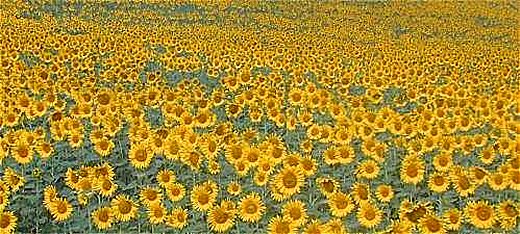
Text Copyright : © 2002 Richard Binns |
We at www.midifrance.net would like to thank Richard for his kind permission to use his text on this page.
If you would like to see his other guides to France, please go to his site : Click
here.
P.S. Sadly Richard passed away on December 14, 2006 at the age of 69, he will be missed.